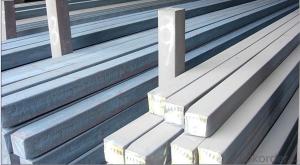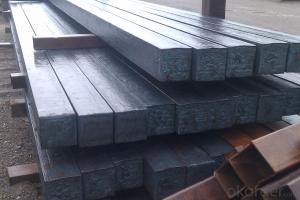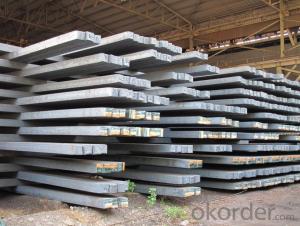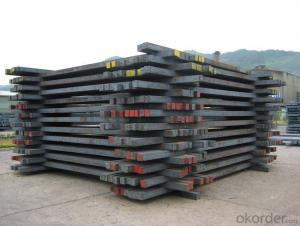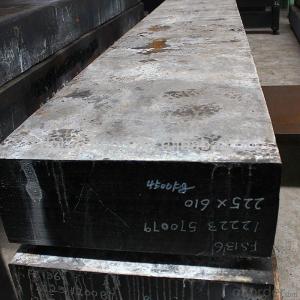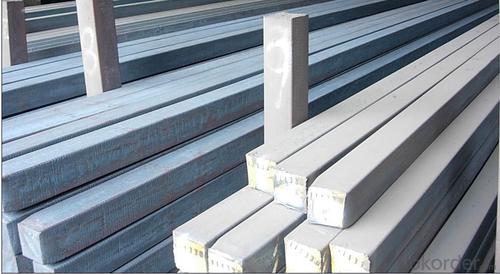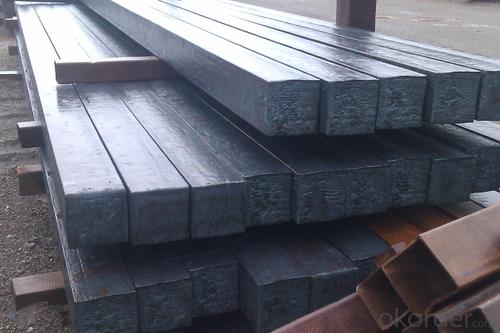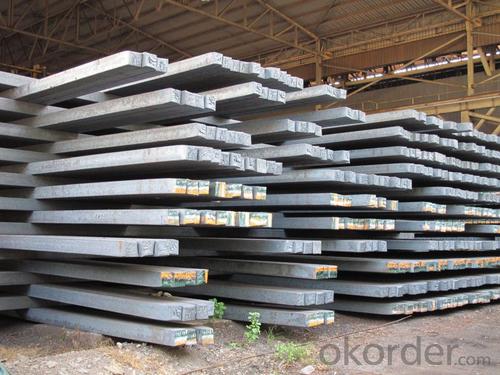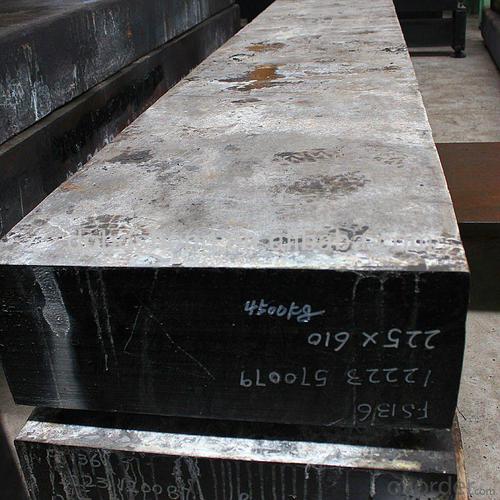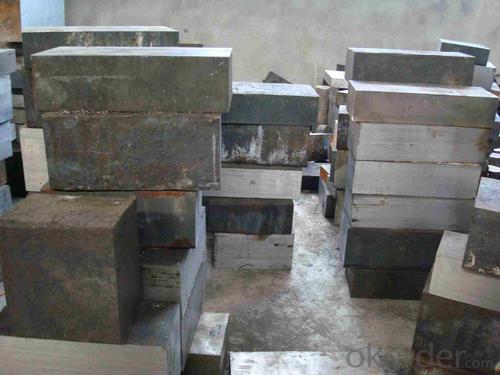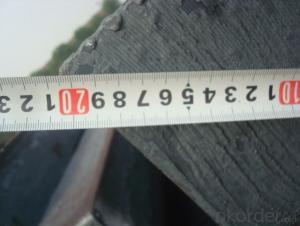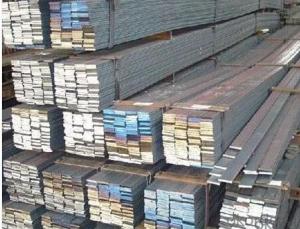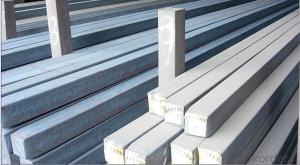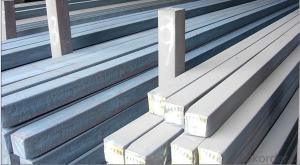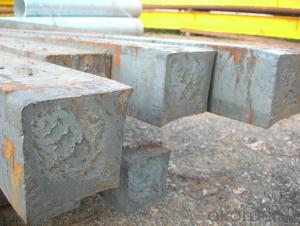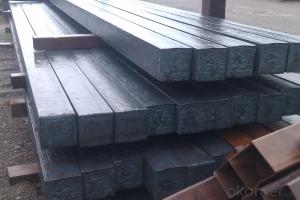Prime square alloy steel billet 130mm Q235
- Loading Port:
- Shanghai
- Payment Terms:
- TT OR LC
- Min Order Qty:
- 100 m.t.
- Supply Capability:
- 10000 m.t./month
OKorder Service Pledge
OKorder Financial Service
You Might Also Like
Structure of Prime square alloy steel billet 130mm Q235
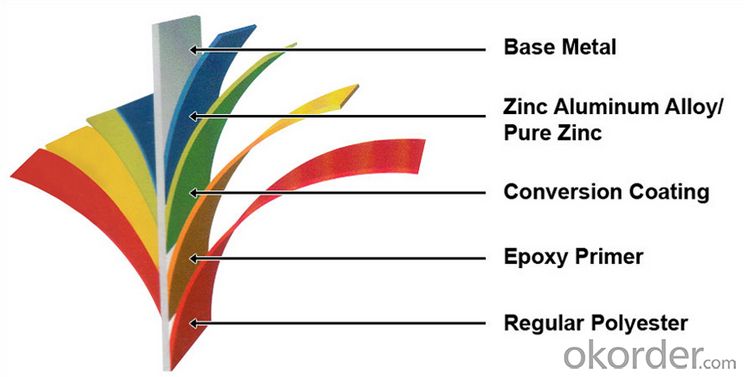
Description of Prime square alloy steel billet 130mm Q235
Manufacture Progress:HRC-CRC-GALVANIZED-COLOR COATED
Application : Construction, electrical, transportation, steel plant, composite board plant, steel tile factory
Payment & Shipping Terms:T/T ,L/C, and FOB CHINA
Minimum Order Quantity: 25Tons
Packge Type: Moisture-proof paper inner,Steel outside,Bundle by steel rope.
Package in Container : Wood as a foot pad, wire rope reinforcement,PPGI steel coil tied together by steel rope.

Main Feature of Prime square alloy steel billet 130mm Q235
Uncoated CR steel sheet
With the features of in line with the international highest standards in demension and shape, excellent surface finish and properties, the products are mainly used in home appliance and automobile industries.
Galvanized steel sheet(include HDG and EG)
With the features of good corrosion resistance, the products are mainly used in automobile, home appliance, electronics, building and machinery manufacture industries, etc.
Precoated steel sheet
With the features of enviromental protection and good processablility, long lasting surface durability, rich in colors, the products are maily used in building, home appliance and furniture industries, etc.
Applications of Prime square alloy steel billet 130mm Q235
1) Excellent corrosion resistance: The zinc layer provides a good protection of Pre-painted Galvanizeed Steel Sheet.
2) High heat resistance: The reflective surface of the material aids in efficiently reflecting the sunlight away and in turn reducing the amount of heat transmitted. The thermal reflectivity converts into energy savings.
3) Aesthetics: Pre-Painted Galvanized steel sheet is available in plethora of patterns and multiple sizes as per the requirements that given by our customers.
4) Versatility: can be used in the various areas.

Specifications of Prime square alloy steel billet 130mm Q235
Product | Billet |
Material Grade | SGCC / SGCH / DX51D+AZ, etc |
Thickness | 0.6-3.0mm |
Width | 500-1500mm |
Tolerance | Thickness: +/-0.02mm , Width:+/-2mm |
Zinc-coating | Z30-150g/m2 |
Technique | Raw material: Hot rolled steel coil --> Cold rolled_>hot dipped galvalume |
Surface | Dried, Chromated, Unoiled |
Spangle | Regular spangle , small spangle, zero spangle |
ID | 508MM 610MM |
Coil weight | 1-25MT |
Export package | Cardboard inner sleeves, Waterproof paper, galvanized steel covered and steel strip packed |
FAQ of Prime square alloy steel billet 130mm Q235
We have organized several common questions for our clients,may help you sincerely:
1. How Can I Visit There?
Our company is located in Tianjin City, China, near Beijing. You can fly to Tianjin Airport Directly. All our clients, from home or aboard, are warmly welcome to visit us!
2. How Can I Get Some Sample?
We are honored to offer you sample.
3. Why choose CNBM?
we always fix steel produce in container well to make it safe arrive at destination port
we always provide best and professional forward service for our buyer
we always apply 14days free detention for our buyers container in destination
we provide one set After-sales service for our buyer
we provide China inland steel market price report
we help our buyer become number one in local market .
- Q: How are steel billets rolled into shape?
- Steel billets are rolled into shape by passing them through a series of rolling mills, where they are subjected to high pressure and temperature. The billets are first heated to a specific temperature to make them more malleable. They are then continuously passed through multiple sets of rollers, which gradually decrease the thickness and increase the length of the billet. This process, known as hot rolling, helps shape the steel billets into various forms such as bars, rods, or sheets.
- Q: How do steel billets differ from steel ingots?
- Steel billets and steel ingots are both intermediate forms of steel that are produced during the steel manufacturing process. However, there are some key differences between them. Firstly, the shape and size of steel billets and steel ingots differ. Steel billets are typically square or rectangular in shape, with a cross-sectional area of around 36 square inches. They are long and slender, usually measuring around 6 to 12 inches in width and 1 to 12 feet in length. On the other hand, steel ingots are generally larger and more irregular in shape. They can be cylindrical, rectangular, or even a combination of shapes, depending on the production method used. Steel ingots are usually much larger than billets, with a typical weight ranging from several tons to over 100 tons. Secondly, the production process for steel billets and steel ingots also differs. Steel billets are usually created through continuous casting, where molten steel is poured into a mold and then cooled and solidified to form a billet. This process allows for a more controlled and uniform shape, size, and composition of the billet. Steel ingots, on the other hand, are typically produced through ingot casting, where molten steel is poured into a large mold and left to solidify. This method is often used for larger steel ingots and allows for a more flexible and adaptable production process. Lastly, the purpose and usage of steel billets and steel ingots also vary. Steel billets are commonly used as raw material for further processing and shaping into various steel products, such as bars, rods, wire, and tubes. They serve as a starting point for the manufacturing of finished steel products. Steel ingots, on the other hand, are usually used for more specialized applications, such as the production of large steel components, forgings, or specialty alloys. Their larger size and irregular shape make them suitable for such demanding applications. In summary, steel billets and steel ingots differ in terms of their shape, size, production process, and usage. While steel billets are slender, square or rectangular in shape, and used as raw material for further processing, steel ingots are larger, more irregularly shaped, and often used for specialized applications.
- Q: Can steel billets be used in the production of energy-efficient appliances?
- Yes, steel billets can be used in the production of energy-efficient appliances. Steel is a versatile and durable material that can be formed into various components of appliances, such as shells, frames, and internal structures. When properly designed and manufactured, steel components can contribute to the overall energy efficiency of appliances by ensuring better insulation, heat distribution, and overall performance.
- Q: What are the main factors affecting the corrosion resistance of stainless steel billets?
- The main factors affecting the corrosion resistance of stainless steel billets include the composition of the stainless steel alloy, specifically the percentage of chromium present, as well as the presence of other alloying elements such as nickel and molybdenum. The microstructure of the stainless steel, including the presence of ferrite and austenite phases, also plays a role in corrosion resistance. Additionally, factors such as the pH and temperature of the environment, the presence of corrosive substances, and the surface finish of the billets can affect their corrosion resistance.
- Q: What are the main factors affecting the fatigue strength of stainless steel billets?
- The main factors affecting the fatigue strength of stainless steel billets include the composition and microstructure of the steel, the presence of surface defects or imperfections, the level of applied stress or load, the presence of corrosive environments, and the temperature at which the billets are operating.
- Q: What are the common surface treatments for steel billets?
- Common surface treatments for steel billets include hot-dip galvanizing, electroplating, painting, and powder coating.
- Q: How do steel billets contribute to energy efficiency?
- Steel billets contribute to energy efficiency in several ways. Firstly, the production of steel billets typically involves recycling scrap metal, which requires significantly less energy compared to producing steel from raw materials. This recycling process helps conserve energy and reduces the carbon footprint associated with steel production. Additionally, steel billets are often used as a raw material in various industries, such as construction and manufacturing. The durability and strength of steel make it a long-lasting and energy-efficient material for building structures and producing goods. Its high thermal conductivity also allows for efficient heat transfer, making it suitable for applications that require temperature control or energy conservation. Overall, steel billets play a vital role in promoting energy efficiency by minimizing energy consumption during production and offering sustainable solutions in various sectors.
- Q: Can steel billets be used in the production of utensils and cutlery?
- Yes, steel billets can be used in the production of utensils and cutlery. Steel billets are semi-finished products that can be further processed into various shapes and forms, including utensils and cutlery. Steel has excellent properties such as strength, durability, and corrosion resistance, which make it suitable for manufacturing utensils and cutlery. Steel billets are often melted and cast into specific shapes, then further processed through forging, stamping, or machining to create the desired utensils and cutlery items. The final products can range from spoons, forks, and knives to more intricate items like serving spoons, ladles, and cheese slicers. Steel utensils and cutlery are widely used and preferred due to their longevity and hygienic properties.
- Q: Is the reaction of carbon and carbon dioxide a redox reaction?
- Is the redox reflect the oxidizing agent is CO2 C 2009-10-22, the reducing agent is the oxidizing agent is CO2, is C 2009-10-22 reductant is redox reaction. Price reduction in carbon dioxide carbonation, was reduced, so is the oxidant.
- Q: How are steel billets used in the production of industrial valves?
- Steel billets are an essential component in the production of industrial valves. These billets serve as the raw material for manufacturing valve bodies, which are the main structural component of the valve. To begin the production process, steel billets are first heated to a specific temperature, usually through the use of a furnace. This heating process is crucial as it allows the billets to be malleable and easily shaped into the desired valve body design. Once the billets reach the required temperature, they are transferred to a special machine called a forging press. In the forging press, immense pressure is applied to the heated billet, causing it to take on the shape of a valve body. This process, known as forging, ensures that the valve body is strong, durable, and able to withstand the high pressures and temperatures of industrial applications. After the forging process, the valve bodies are then machined to achieve the final shape and dimensions. This involves using cutting tools to remove any excess material and refine the surface finish. The machined valve bodies are then inspected for quality assurance to ensure they meet the required specifications and standards. Once the valve bodies are ready, they undergo additional processes such as heat treatment and surface coating to enhance their strength, corrosion resistance, and overall performance. These treatments help to ensure that the valves can withstand harsh operating conditions and have a long service life. In summary, steel billets play a critical role in the production of industrial valves. They are heated and forged to create the valve bodies, which form the structural foundation of the valves. Through additional machining, heat treatment, and surface coating processes, the billets are transformed into high-quality valves that can effectively control the flow of fluids or gases in various industrial applications.
Send your message to us
Prime square alloy steel billet 130mm Q235
- Loading Port:
- Shanghai
- Payment Terms:
- TT OR LC
- Min Order Qty:
- 100 m.t.
- Supply Capability:
- 10000 m.t./month
OKorder Service Pledge
OKorder Financial Service
Similar products
Hot products
Hot Searches
Related keywords
